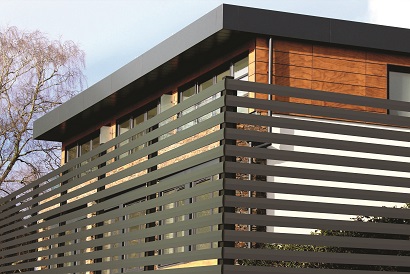Fire-Proof Decking To Be Laid At Latham
EnviroBuild has signed a contract with Taylor Wimpey for its 150 Aqua Channel aluminium decking in the refurbishment of the balconies at Latham’s...
Read Full Article
Paul Smith, of F.H. Brundle, writes on the topic of the modern materials shaking up the fencing and decking sectors and making the nation a more stylish, less labour-intensive place to be.
Since the turn of the millennium, rapid advances in technology have seen traditional materials increasingly replaced with stronger, longer-lasting and easier to maintain alternatives.
It’s unlikely the humble timber fence or metal railings will ever disappear completely – but now they have serious competition.
New man-made materials such as WPC – wood-plastic composite – can deliver the timeless timber aesthetics that homeowners like so much, but without timber’s many drawbacks.
Where wood is susceptible to rotting and warping, WPC products are water-resistant. Where timber needs costly, time-consuming and regular maintenance, WPC products require virtually none – and what’s more, their longer life-span mean they need replacing less often.
Long-lasting, easy-maintenance decking
WPC has quickly become a leading material in the decking sector, as well as becoming popular for fencing, cladding and more.
At F.H. Brundle, for instance, we supply the Rinato range of WPC fencing and decking – offering the look of wood, without the hassle.
With the option for a natural woodgrain finish, it is able to offer much-sought after traditional aesthetics, but is much stronger, longer-lasting and virtually maintenance free. It has high UV resistance and testing that proves that it is anti-slip, as well as flame and splinter-resistant.
Rinato combines Forest Stewardship Council-certified recycled eucalyptus wood and non-toxic recycled polyethylene or polypropylene, making it both incredibly strong and environmentally friendly.
Polymer’s got potential
Alongside our WPC offering, Rinato polymer fencing is another popular timber alternative, and the range has just been expanded for 2021.
The wrapped range comes in three finishes, golden oak, anthracite and rustic oak, and all feature a decorate wood-effect laminate wrap perfect for situations where fences need to look good.
The new embossed range is more cost-effective, but still provides a realistic heat-embossed woodgrain finish with a choice of four colours – black, grey, brown and green.
Both work with our post and channel system, that allow boards to be fitted to virtually any post, and the polymer to naturally expand.
Aluminium
But WPC isn’t the only modern alternative challenging timber’s dominance.
Aluminium was once a material you would associate with sleek commercial buildings and high-end windows and doors – but now, the style and strength that’s made it so popular in other sectors is now seeing it increasingly adopted elsewhere, too.
Just this year, for instance, we’ve unveiled our new synergised decking system for balconies, roof terraces, walkways and gardens.
Designed in the UK, synergised decking is made from structural-grade 6063 T6 aluminium, and finished with a 100 micron Qualicoat premium powder coating, making it ideal for high-traffic areas.
Stylish, versatile fencing
In recent years, we’ve seen aluminium and WPC shake up the fencing market, too. Long-lasting, maintenance-free and easy to handle and install, lightweight Marano slats and boards come in both a realistic golden oak timber effect finish, and a contemporary anthracite grey.
Within the Marano range, you find a variety of different systems.
Elements is arguably the most versatile – letting you create modern fencing with a combination of double-sided boards, aluminium strips, and acrylic panels that can be supplied either frosted or clear.
Marano convex slats can be fixed to the external face of virtually any fencing posts, for a striking and quick-to-install privacy fence as well as being incorporated into steel gate frames
Our marano stripe fencing boards are double-sided – on one side, you find a contemporary flat design, while they feature a traditional grooved effect on the other.
Thousands of installers around the country are already benefitting from the strength and stability of WPC, polymer, aluminium, and other alternatives – and if you’re interested in joining them, we’d be delighted to help.
Picture: Wood-plastic composite products from F.H. Brundle.
Article written by Cathryn Ellis
15th October 2021